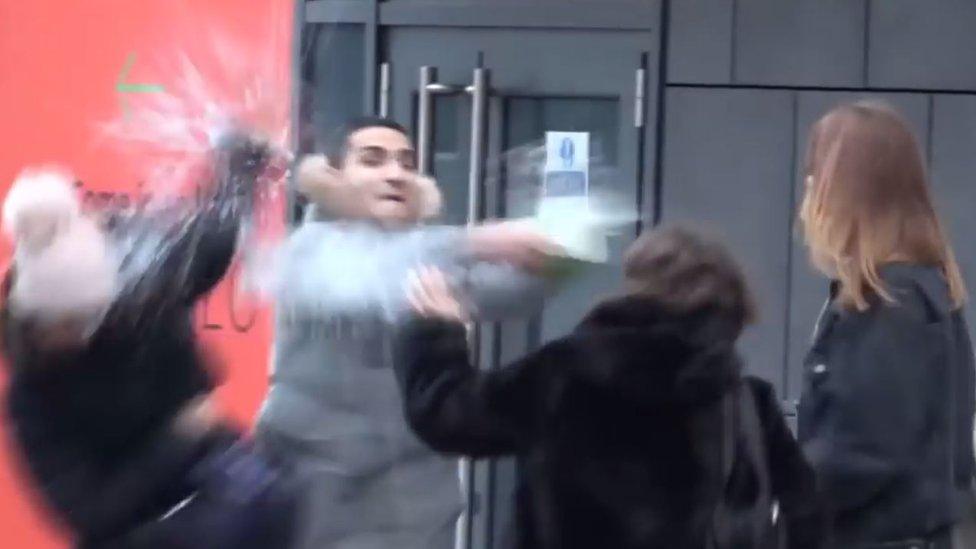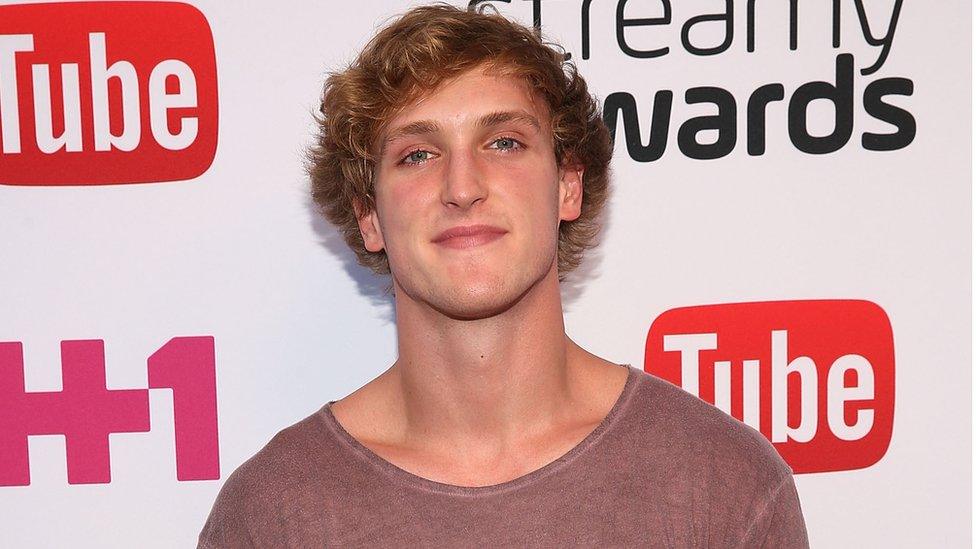Who's posting extreme 'terror pranks'?
- Published

Security footage shows the panic caused by a prank at London's National Portrait Gallery
Fake bombs, staged murders, stunts that resemble acid attacks - as competition for eyeballs on YouTube gets fiercer every day, popular vloggers are resorting to extreme pranks to get clicks.
Arya Mosallah's video channel had more than 650,000 subscribers. But his YouTube career came skidding to a halt with a video titled "Throwing Water On Peoples Faces PT. 2". In it, he approaches several people, and after a brief conversation, throws a cup of water in their faces.
Many viewers thought the prank in the video looked like an attempt by the British social media star to mimic an acid attack - amid a recent increase in such crimes in London and across the UK.
Allow X content?
This article contains content provided by X. We ask for your permission before anything is loaded, as they may be using cookies and other technologies. You may want to read X’s cookie policy, external and privacy policy, external before accepting. To view this content choose ‘accept and continue’.
YouTube deleted Mosallah's channel - and then a second channel he set up. He told the BBC he had not meant to reference acid attacks - but that he would continue to produce prank videos.

This notice on Ayra Mosallah's YouTube page explains why the video sharing site took down his channel.
But Arya Mosallah is certainly not the first YouTuber to get into trouble for prank videos. His story, along with the controversy over hugely popular Youtuber Logan Paul joking about a suicide victim to his young audience, have called attention to extreme content on YouTube.
But although it appears to be on the rise - and is getting more coverage from news outlets - extreme pranking is not an entirely new phenomenon. For some time, vloggers have been faking bomb attacks and murders, tricking and frightening friends and members of the public in an attempt to up their view counts.

Arya Mosallah says his stunt wasn't intended to appear like a real acid attack
Extreme prank history
In 2016, four people involved in the YouTube channel Trollstation were jailed for staging a fake robbery at London's National Portrait Gallery. They pleaded guilty to "threatening behaviour causing fear of unlawful violence."
The previous year, British YouTuber Sam Pepper uploaded a video in which he pretended to kill another internet celebrity in front of an unsuspecting friend.
There was a huge backlash and Pepper later claimed the video had been staged, and that the apparently traumatised friend had been in on the stunt all along.
Perhaps the grandfather of extreme pranking is Vitaly Zdorovetskiy, whose YouTube channel gained notoriety in 2012 after he pretended to put a briefcase containing a bomb next to a stranger.
He was arrested for that and several other subsequent pranks and stunts. But YouTubers including Arya Mosallah, have been filming variations of his bomb prank ever since.
Speaking to Trending in 2015, Zdorovetskiy admitted pushing the boundaries of acceptable behaviour. He also seemed unclear about exactly where he would draw the line.
"I'm not going to take a gun on somebody point it and say 'Give me your money, it's a prank.' I would not do anything illegal - maybe just a little bit."
Logan Paul isn't primarily known as a pranker, but has done similar stunts. In one video he faked his own violent death in front of a crowd of fans.

YouTuber Logan Paul
On Friday, YouTube suspended advertising on his channel. In a statement the company said that Paul had exhibited "a pattern of behaviour in his videos that makes his channel not only unsuitable for advertisers, but also potentially damaging to the broader creator community."

You might also be interested in

The question of whether the pranks are unleashed on unsuspecting members of the public or are instead sprung on actors or friends of the YouTube stars is a crucial one. Mosallah refused to comment to BBC Trending about whether his pranks were unleashed on random strangers. But he hinted that they may have been staged.
Arya Mosallah: "The media kind of demonised me."
"What if what if the videos were staged - do I deserve to get my channel taken down?" he said. "What if it was a little short film -what if all this wasn't real?"
'Moment of shock'
Trending asked Judi James, a body language and behavioural expert, to examine the water-throwing video, and she said the clips "look as though they've been staged"
"There's usually the moment of shock… but in this case (the victims) almost straight away start running after him. One guy even leaves a large bag on a park bench which is probably counter-intuitive.
"I'm guessing they're not all what they seem to be although some of them might be," she says.
Behind the scenes with Trollstation
As YouTube becomes increasingly saturated with young people trying to make their name in on a rapidly developing platform, some have turned to extreme ways to get attention, rack up clicks, and - under YouTube's advertising-reliant model - get paid. Extreme pranks are one way to cut through the noise.
"It's probably the most sadistic form of comedy," James says. "Every day we get bombarded with more and more graphic films of cars crashing, terrible events taking place, and even people dying. Once you start to break the barriers and look at those then the idea of seeing comedy that is actually quite sadistic becomes even more appealing."
"A lot of it is schadenfreude, external - it's a bit like bullying at school, you're almost laughing tinged with a relief that 'it's not me.'"

Hear more

"The other thing to think about is the fact that the pranksters themselves can actually suffer from doing the pranks," James says. "Longer term. empathy has a way of catching up with us. Either you have no empathy at all which is quite unusual, or you are often going to get flashbacks about all those people you have upset."
That seemed to be the case for at least one of the Trollstation prankers, Daniel Jarvis, who spoke to Stephen Nolan on BBC Radio 5live.
"I disliked it," Jarvis said of the National Portrait Gallery robbery prank which landed him in jail. "It weren't a nice feeling when I seen all these people scared… that's not what I'm about."
Do you have a story about the world of social media? Email Trending, external.
More from Trending: The anti-immigration politician... who's an immigrant

Hanif Bali is a controversial figure in Swedish politics. Among other things - he wants to stop all asylum seekers from entering the country. He's also an immigrant. WATCH NOW
You can follow BBC Trending on Twitter @BBCtrending, external, and find us on Facebook, external. All our stories are at bbc.com/trending.